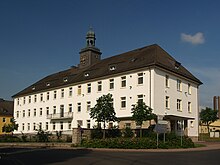McPheeters Barracks
McPheeters Barracks was the name of a barracks in Bad Hersfeld used by the US Army from 1945 to 1993 . It was built for the German Wehrmacht from 1935 onwards . Until 1945 it was called "Langemarck-Kaserne" after the battle of Langemarck .
history
Wehrmacht
1935 in Bad Hersfeld District High air near the already planned and in 1940 completed highway , as part of the upgrade of the armed forces staked out an area of 9 hectares for the construction of a barracks. She served the motor vehicle replacement department No. 9 of the army . The facility consisted of a staff building highlighted by a ridge turret, an officers building, three crew buildings, a farm building, a workshop building, a gymnasium and six vehicle halls.
US Army
On March 13, 1945, the city of Bad Hersfeld was captured by Kampfgruppe B of the 4th US Armored Division . From April 10 to April 22, 1945, the barracks housed the headquarters of the 3rd US Army under General George S. Patton , who planned the further advance to the east from there. The general and later President Dwight D. Eisenhower also stayed temporarily in the barracks. Shortly afterwards, the 7th US Infantry Regiment moved into the barracks.
In 1946, the 91st squadron of the US Constabulary followed , which now performed occupation duties. The barracks was named in 1948 after an officer of the “McPheeters Barracks” battalion who fell in World War II .
From 1950, the “McPheeters Village” was built south of the barracks , a residential area for the soldiers and their families. It was equipped with schools, club rooms, sports facilities, a shopping center with a bank and post office, a library and a cinema.
During the use by the US Army , the barracks functioned primarily as a location for armored US cavalry regiments (Armored Cavalry Regiment (ACR)) . By changing the flag from the 14th ACR to the 11th ACR Blackhorse, Bad Hersfeld became the location of the 3rd Squadron of the 11th ACR Blackhorse ( 3rd Squadron 11th ACR Blackhorse ) from 1972 . The barracks was extensively modernized and expanded for this purpose. 41 M1 tanks and 36 Bradley armored personnel carriers were stationed there; the helicopter company was raised to squadron strength. The barracks area was extended by 8 hectares to the east for the necessary storage and factory halls. The units were tasked with securing the inner-German border in the highly vulnerable section of the so-called Fulda Gap . From December 1991 the 11th Armored Cavalry Regiment was relocated to Kuwait and Turkey to participate in the Gulf War .
In the summer of 1993, the city of Bad Hersfeld was informed that the US Department of Defense had decided to dissolve the garrison in Bad Hersfeld. The last soldiers left the barracks in November 1993.
Todays use
The land then fell to the Federal Property Office . In order to bring them to an orderly recovery, the city of Bad Hersfeld commissioned the Hessische Heimstätte GmbH (today “Wohnstadt Hessen GmbH” ) with an urban development study and planning, on the basis of which the area was developed from an urban planning perspective while preserving usable buildings. The apartments were added to the rental housing market. Commercial areas were created in the technical areas and the Bad Hersfeld customs office , the adult education center and service providers moved into the former accommodation buildings .
literature
- Elmar Nolte u. a .: Expert opinion on the conversion of the McPheeters Barracks , Ed .: Hessische Heimstätte GmbH, Kassel 1994

